John the Baptist
John the Baptist, Latin John Baptista (born c. 5 BC; died c. 30 or before 36 AD.) (Hebrew Yokhanan HaMatbil יוחנן המטביל; classical Syriac ܝܘܚܢܢ ܡܥܡܕܢܐ Jochanan Mamdana; Greek Ἰωάννης ὁ βαπτιστής Iōánnēs ho Baptistḗs ancient Greek Ἰωάννης ὁ βαπτίζων; Latin Io(h)annes Baptista; Spanish San Juan Bautista or Santibañez; Slavic Ivan) was a Jewish penitential preacher who lived around 28 CE. Chr. appeared in Galilee and Judea. He was active in Palestinian Judaism and also had followers in the Jewish Diaspora. His historicity is disputed, but according to today's prevailing view is vouched for by the Jewish historian Flavius Josephus.
John is portrayed in the New Testament, written in Greek by early Christians, as a prophet of the end times and a forerunner of Jesus Christ with his own following. Subsequently, many churches venerate him as a saint. The Mandaeans traced their religion back to him and regard him as their chief reformer. In the Qur'an, the holy scripture of Islam, John is the third last prophet before ʿĪsā ibn Maryam (Jesus) and Mohammed (Sura 3:39).
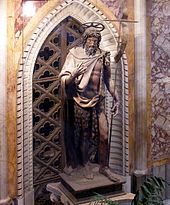
Statue of John the Baptist below the papal altar in the Lateran Basilica dedicated to him.
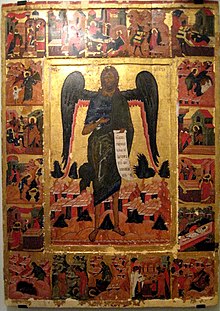
St. John the Baptist with angel wings and 18 scenes from his life. School of Nizhny Novgorod, 16th century.
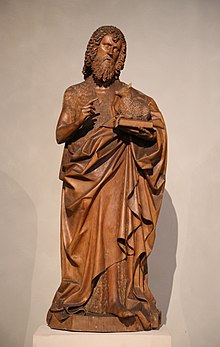
St. John the Baptist by Hans Multscher, c. 1459. Bavarian National Museum Munich
Birth and childhood
The narratives about the birth and childhood of the Baptist in Lk 1-2 EU are probably of little historical weight. Here some theologians assume personal legends from the circle of the Baptist worshippers, who want to transfer the later meaning of the Baptist already to the events around the birth and childhood of John and illustrate them with the help of Old Testament motifs. But these texts are by no means unproductive for a historical reconstruction. According to Lk 1,13-15 EU John is announced before his birth by the angel Gabriel as a man abstinent from wine and intoxicating substances. According to Am 2,11f EU this wine asceticism can be interpreted as characteristic for prophets.
John probably comes from a priestly lineage: According to Luke's gospel John was the son of the priest Zacharias from the priestly class Abijah and Elizabeth from the lineage of Aaron (Lk 1,5 EU). Since the priestly class Abijah was one of the less important of the 24 priestly classes (1 Chr 24,19 EU), this could well be a reliable information.
According to Lk 1,5 EU John was born "in the time of Herod, king of Judea"; he reigned from 38 B.C. to 4 B.C. In Lk 1,39 EU the reader learns about the place of residence of Elizabeth: "a city in the mountains of Judea". Already this imprecise information indicates the low historical interest of the author, who is essentially interested in a statement on the theological level of meaning.
Speculations about a Qumran stay of the young John based on Lk 1:80 EU cannot be historically verified. With the specification "lived in the desert until the day when he received the commission to appear in Israel" the motive of staying and working in the desert, which characterizes the Baptist as a prophet, might have been brought forward to the time before his calling.
See also: St. John's Day
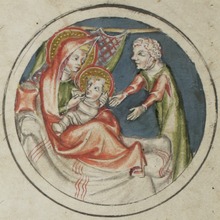
Elisabeth nursing the newborn John, Klosterneuburger Evangelienwerk, ca. 1340
Time and place of occurrence
According to Lk, John's appearance begins "in the fifteenth year of the reign of the emperor Tiberius" (Lk 3:1 EU), which refers to the years 26-29 AD. The fifteenth year of Tiberius' reign was in AD 26/27 or 29/30, depending on whether one reckons his years of reign from the time of his co-rule with Augustus (Autumn 12) or from the time of his sole reign (August 14). The vagueness of the dating also results from the uncertainty as to whether the author had the year begin according to the Seleucid or Roman calendar commonly used in the Orient.
The biblical indications of place give a contradictory finding about the place of the appearance of the Baptist: in the desert at the Jordan (Mk 1,3-5 EU), in the desert of Judea (Mt 3,1 EU), Bethany, beyond the Jordan (Joh 1,28;10,40 EU) or in Aenon near Salim (Joh 3,23 EU). Travel groups today are presented with the "authentic" baptismal site on both the west bank of the Jordan (West Bank) and the east bank (Jordan). However, the Jordanian east side may claim the better arguments. Only there, in the Perea of the Bible, did Herod Antipas have the right to imprison the Baptist (Mark 6:17-29 EU; Jos Ant XVIII 5:2); Old Testament traditions also seem to have played a role in the choice of location for John (Jos 3 and 4 EU; 2 Kings 2:1-18 EU). Only in later centuries was the place of baptism located on the western bank of the Jordan, mainly for practical reasons; the earliest evidence for this tradition is the famous mosaic of Madaba (6th century), the oldest surviving map of Palestine.
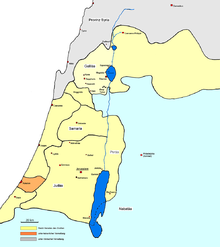
Judea, Samaria, Galilee and Perea at the time of Herod, client king from ca. 39 B.C. - 4 B.C.
Search within the encyclopedia